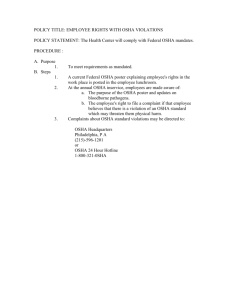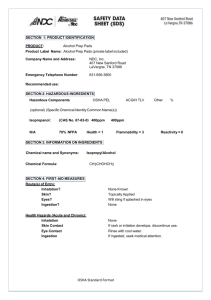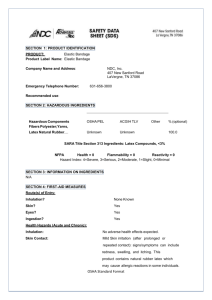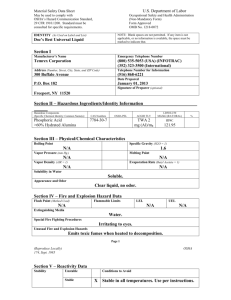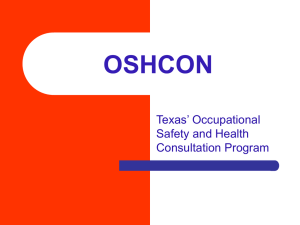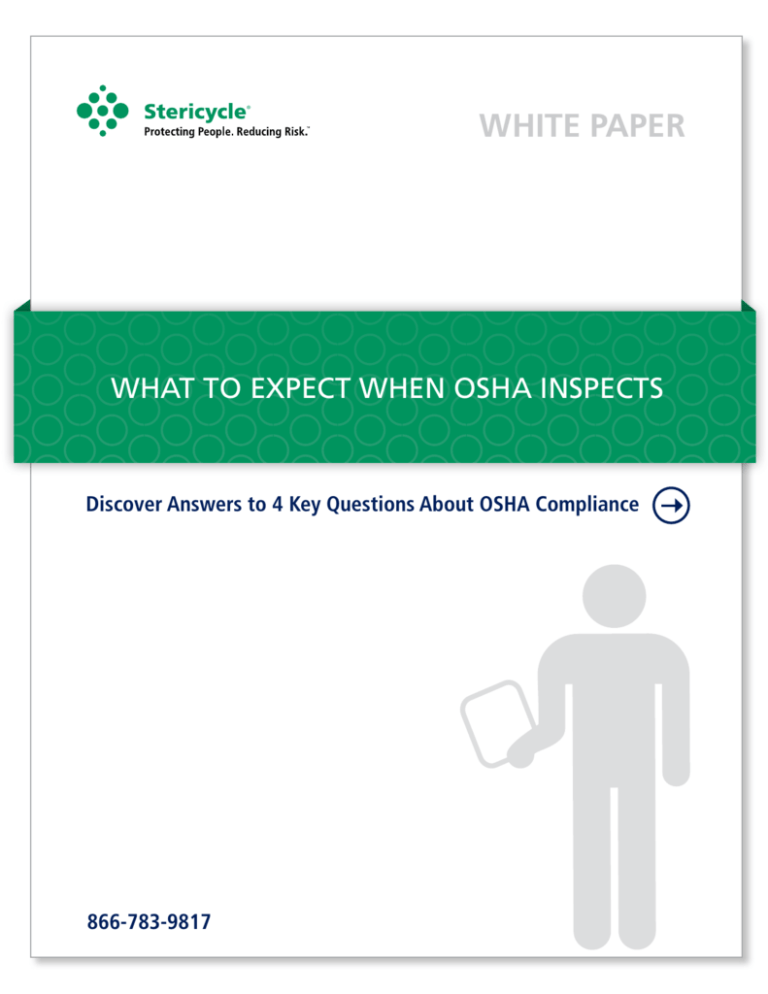
WHITE PAPER
WHAT TO EXPECT WHEN OSHA INSPECTS
Discover Answers to 4 Key Questions About OSHA Compliance
866-783-9817
TABLE OF CONTENTS
4 Key Questions
1
2
3
4
Page
Can OSHA Really Just Show Up?........................................................................ 1
Why Did OSHA Choose Us?............................................................................... 2
What Happens During an Inspection?................................................................ 4
What Happens After an Inspection?................................................................... 7
The Answers
Compliance Is the Solution.............................................................................. 11
Benefits of Workplace Compliance ................................................................. 12
}
How Stericycle Can Help.................................................................................. 12
References
12
13
Get Help with OSHA Compliance • 866-783-9817
WHAT TO EXPECT WHEN OSHA INSPECTS
Answers to 4 Key Questions About OSHA Compliance
The Occupational Safety and Health Administration (OSHA) is responsible for ensuring
the safety of the U.S. workforce. Keeping healthcare workers safe helps to ensure there
will be healthcare workers to continue safeguarding the overall well-being of society.
It’s also the law.
This white paper will answer four key questions about OSHA compliance and discuss what
to expect during and after an OSHA inspection.
1
CAN OSHA REALLY JUST SHOW UP?
Respect OSHA’s Right of Entry
Does OSHA really have the right to enter a particular
workplace? The short answer is: you bet it does! Through
the Occupational Safety and Health (OSH) Act, Congress
granted OSHA broad authority to enter without delay
into any workplace or environment where an employee
of an employer works.1 OSHA also has the authority to
examine “all pertinent conditions, structures, machines,
apparatus, devices, equipment, and materials,”
including any applicable records.
Create Good Will
It is not advisable to attempt to prevent OSHA from
entry or from exercising its Congressional mandate.
Generally, if such resistance is encountered, OSHA will,
in fact, leave the premises, but that doesn’t mean it
does not have the authority to enter, or that its departure
will be anything but short-lived. OSHA will, indeed,
return, this time with a compulsory court order or
inspection search warrant, and entry into the workplace
will occur, if necessary with the assistance of a U.S.
Marshal. The amount of ill will that an employer would
engender through an ill-advised attempt to prevent
OSHA’s entry would undoubtedly be self-defeating and
counterproductive.
Comply Before OSHA Enters
WHO’S NOT COVERED
UNDER OSHA?
Self-employed
workers/Sole
proprietors
without
employees
Immediate
family
members
of farm
employers
Workplaces With Hazards Regulated
by Another Federal Agency
Mine Safety and Health
Administration
Department of Energy
Federal Aviation
Administration
Coast Guard
Source: All About OSHA.2
Far better to simply ensure your facility has been brought into compliance with OSHA’s requirements,
before OSHA ever shows up at the front desk. An employer who has already taken the proper steps to
comply with OSHA’s requirements and who is welcoming to OSHA will obviously be more favorably viewed
than one who is recalcitrant, resistant, or even hostile. A workplace that is already properly prepared for an
OSHA visit will have little to fear from OSHA’s entry at the outset.
12
www.Stericycle.com/OSHA
Get
Help with OSHA Compliance
1
Consider a “Reasonable” Time
The OSH Act restricts OSHA’s inspection of
workplaces to “regular working hours and at other
reasonable times.” A medical or dental office that is
handling a patient surge can ask the OSHA officer if
she would mind coming back at a more convenient
time. The officer may still say no, but it doesn’t hurt
to ask, and chances are the officer will agree that
a less hectic time would be more conducive to a
proper inspection for the officer as well.
2
BEWARE THE IMPOSTOR!
When an OSHA compliance officer visits
your facility, do not hesitate to ask to
see credentials. Instances of persons
impersonating OSHA officers and
seeking to collect alleged penalties on
the spot have occurred. If there is any
question, telephone and check directly
with the associated OSHA office.3
WHY DID OSHA CHOOSE US?
Programmed Inspections
The primary reason OSHA visits a healthcare workplace is to conduct a “programmed” inspection.
Programmed inspections are those that are scheduled because of various criteria that OSHA is
interested in at a particular time.
Perhaps your workplace is a type that is recognized as having a high hazard rate, and OSHA has
decided to conduct inspections for these types of employers.
OSHA sometimes has National, Regional, or Local Emphasis Programs or Special Emphasis Programs
underway to conduct inspections of facilities that are covered by a Standard, such as those that are
covered by the Bloodborne Pathogens Standard. For example, in 2012 OSHA announced a three-year
National Emphasis Program focusing on nursing homes and residential care facilities.4
OSHA is founded
1970
By
2012
an estimated 14,000
workers are killed on the
job each year, around
38 people per day
the number of deaths falls
to 4383, about 12 workers per day
Source: All About OSHA.2
12
Get Help with OSHA Compliance • 866-783-9817
2
Each year
Unprogrammed Inspections
Unprogrammed inspections are those that result in situations of
imminent danger—such as instances of workplace injuries,
fatalities, or specific employee complaints.
$53 billion
}
Imminent Danger
The first kind of unprogrammed inspection that OSHA will conduct is
in situations where there is imminent danger or reasonable certainty
that an immediate danger exists. These situations are responded
to first because of the potential for avoiding future injury or
catastrophe through a timely intervention.
Occupational injuries
and illnesses cost
American employers
Catastrophes or Fatalities
The next type of situation to which OSHA responds is one where
a catastrophe or fatality has already been reported to OSHA.
Such unprogrammed inspections are handled after imminent
danger cases, because it is already too late to avoid injury.
>$1 billion a week
in workers’ compensation costs
alone
Source: All About OSHA.2
Complaints and Referrals
The third kind of situation to which OSHA responds occurs when a complaint is made to OSHA about your
specific workplace. Complaints or referrals may come from:
1) Current or former employees of your facility
2) Any bona fide representative of an employee
3) Professionals and/or healthcare workers outside of your facility
4) Patients
For example, a healthcare worker in an occupational health clinic might notice a pattern in the types of injuries
from a particular workplace. Such an observer, even though not an employee of the workplace in question,
could make a “referral” to OSHA, and OSHA might conduct an inspection based on that referral.
Members of the clergy, social workers, and spouses can also make referrals. Likewise, attorneys or union
representatives may make a referral to OSHA that results in an inspection.
Keep in mind, OSHA does not have any direct purview over patients and patient treatment. However, if OSHA
receives a complaint from a patient about working conditions the patient has observed in your office,
OSHA might treat such a complaint as a referral. An investigation might result to discover whether or
not the patient’s allegations are correct. Furthermore, studies have shown a link between patient safety
5
and worker safety.
Truth be told, just about anyone who happens to know about a workplace safety or health hazard at a
workplace can report the situation to OSHA, and OSHA might conduct an inspection as a result. Moreover,
if a person making a complaint to OSHA wishes to remain anonymous, then OSHA will respect that request,
6
and the complainant’s identity won’t be revealed.
12
www.Stericycle.com/OSHA
Get
Help with OSHA Compliance
3
3
WHAT HAPPENS DURING AN INSPECTION?
“If a person making a complaint
The Opening Conference
The first order of business for an OSHA Compliance Safety
to OSHA wishes to remain
and Health Officer (CSHO, pronounced “Co-SHOW”)
anonymous, then OSHA will
conducting an inspection of your office or facility will be
respect that request, and the
to conduct an opening conference. During this conference
the officer will inform you specifically about why she is
complainant’s identity won’t
visiting your particular workplace. Perhaps it is because
be revealed. 6
of a National Emphasis Program or a Special Emphasis
Program that is underway and that has application in your
workplace. If, for example, there happens to be a special program to assess how affected workplaces
are complying with the Bloodborne Pathogens Standard, the officer will explain that she is conducting a
programmed inspection related to that topic. If the officer is there as the result of a complaint or referral,
however, then that information will be shared.
”
The Situation
Usually a single compliance officer, dressed in business attire, conducts an OSHA inspection. On occasion,
however, other personnel, such as industrial hygienists, or other persons with pertinent expertise, may also
be involved.
}
The compliance officer’s guidance or “checklist” for conducting an inspection consists of documents
known as “the FOM” and various OSHA “directives.” FOM, is the acronym for OSHA’s Field Operations
Manual, a document that provides detailed instructions for officers about procedures to be followed.
Further guidance and direction on specific OSHA Standards are available in the documents known
7
as “directives,” such as the directive for the Bloodborne Pathogens Standard.
Each year
> 3.3 million
working men and women
suffer a serious job-related
injury or illness
Source: https://www.osha.gov/Publications/all_about_OSHA.
12
millions more are exposed
to toxic chemicals that
may cause illnesses
years into the future
Get Help with OSHA Compliance • 866-783-9817
4
The Wall-to-Wall Inspection
Review of Records and Required Documents
In healthcare workplaces, where OSHA’s Bloodborne Pathogens Standard has wide application, you
can expect that the officer will ask to see the site’s written Bloodborne Pathogens Exposure Control
Plan (ECP) within minutes of arrival. The officer may take a copy of the ECP for detailed examination
and scrutiny off-site, and any deficiencies will almost certainly result in Serious category citations
along with an appropriate financial penalty for each violation.
The officer will ask to see the facility’s written Hazard Communication Program and any other
pertinent written programs that apply to that workplace, such as written Respiratory Protection
Programs, Emergency Action Plans, Fire Prevention Plans, etc. The officer will look to see that
the plans are current, and that those plans requiring annual review and update (such as the
Bloodborne Pathogens Exposure Control Plan) have, indeed, been reviewed and updated within
the previous 12 calendar months. The officer will ask to see that Safety Data Sheets for all
hazardous chemicals in the workplace are readily accessible to employees.
Required medical records such as hepatitis B vaccination records or documentation of any
needlesticks or other sharps injuries will be examined. Training records will be scrutinized.
Any Personal Protective Equipment use (or non-use) will be examined.
OSHA MAY WANT TO SEE YOUR COMPLIANCE WITH THE FOLLOWING:
Bloodborne Pathogens Standard
Personal Protective Equipment (PPE)
Respiratory Protection
Hazard Communication Standard
Training Requirements
Aerosol Transmissable Diseases
Injury and Illness Prevention Program
(Safety and Health)
Formaldehyde
New Employee Orientation
Emergency Preparedness
For a more complete list of areas that may result in
an OSHA violation, obtain a copy of Stericycle’s
Introduction to OSHA Guide.
Source: Introduction to OSHA8
12
www.Stericycle.com/OSHA
Get
Help with OSHA Compliance
5
Private Interviews and Other Documentation
The officer will look to see that the required written plans are readily accessible to employees. OSHA
may also conduct private interviews with employees at your office. The officer may even take air
samples, photographs, or videos.
The Closing Conference
When the “wall to wall inspection” has been completed, OSHA will hold a closing conference
with the employer to share the officer’s findings. OSHA will not, however, issue citations at the
time of the closing conference. The compliance officer will not provide any written documentation
to the employer at the conclusion of the inspection, but she will verbally inform the employer about
apparent violations that have been observed and that require abatement or correction. The reason
the violations are described as “apparent” violations at this point is because no citations are actually
issued during an inspection itself. The issuance of citations and penalties occurs later.
Who’s Covered by OSHA? All 50 States and More!
OSHA-Approved State Plans (private
sector and public employees)
Federal OSHA (private sector
and most federal employees)
WHAT IS AN OSHA STATE PLAN?
OSHA-Approved State Plans
(for public employees only;
private sector employees are
covered by Federal OSHA)
Federal OSHA-approved programs operated as “mini-OSHAs” by individual states. State-run
programs are required to be at least as strict and effective as the federal program.
Federal workers are covered by Federal OSHA in all 50 states.
Source: OSHA Approved State Programs9
12
Get Help with OSHA Compliance • 866-783-9817
6
4
WHAT HAPPENS AFTER AN INSPECTION?
Area Director Review
The OSHA officer will go back to her area office and will meet with the area director, or the
equivalent to an area director in states with OSHA plans. The findings of the inspection will
then be reviewed. OSHA may confer with industrial hygienists and lawyers in determining
how to proceed. Ultimately, however, it is the OSHA area director who has the authority
to issue citations.
Citations and Penalties
Typically, an employer will receive notice of any citations in the mail, and the employer will also be
informed of any penalties that are due at the same time. The employer will be given an “abatement
date,” meaning a date by which the employer must correct any deficiencies that OSHA noted.
OSHA’s Most Frequently Cited Violations
The vast majority (approximately 70% to 75%) of all OSHA citations and penalties levied against
healthcare employers are associated with violations of the Bloodborne Pathogens Standard.10
Violations of the Hazard Communication Standard make up a distant second at approximately
15%.10 To help healthcare facilities understand what they must do, Stericycle offers its Steri•Safe
OSHA Compliance Program that emphasizes
satisfying requirements for both of these
Standards as well as other pertinent
OSHA requirements.
SM
The remainder of the top ten
most-frequently-cited violations
for medical/dental offices is typically
for noncompliance with additional
Standards having to do with personal
protective equipment, first aid, fire
extinguishers, exit routes, and
electrical safety.
Standards Cited in Violations
at Healthcare Facilities
Bloodborne Pathogens Standard
70-75%
15%
Hazard
Communication
Standard
10-15%
Misc.
Source: OSHA Data and Statistics10
12
www.Stericycle.com/OSHA
Get
Help with OSHA Compliance
7
Amount of Penalties
Congress, in the Occupational Safety and Health Act of 1970, set the maximum amount of civil penalties
that OSHA can assess per violation, and that amount has been increased since that time.
Violations of the Bloodborne Pathogens and Hazard Communication Standards are typically judged to be
Serious violations, and the penalty for Serious violations, as stipulated in the OSH Act, may be assessed in
amounts of up to $7,000 each.3 In the case of violations of training or PPE requirements, however, the
penalties can be assessed per the number of employees affected.
The result is that OSHA, in fact, has wide discretion and leeway in determining the total dollar amount of
penalties that can be realized.
OSHA has a number of violation levels
Penalty Factors
Section 17 (j) of the OSH Act provides that penalties shall be assessed giving due consideration to four factors:11
1) Gravity of the violation
2) Size of the employer’s business
3) “Good faith” of the employer
4) Employer’s history of any previous violations
An individual healthcare employer can easily receive several Serious violations during a typical OSHA
inspection. The 2014 head of OSHA, Dr. David Michaels, has gone on record stating that he feels
strongly that penalties for OSHA violations provide a necessary incentive for employers to be in
compliance, and he is in favor of raising the maximum amount of penalties.12 At $7,000 per violation,
it doesn’t take long for significant amounts of penalties to accumulate. Assuming five Serious violations,
even if assessed at only $5,000 per penalty, instead of the currently permissible maximum of $7,000, the
payout would total $25,000.
“Violations of the Bloodborne Pathogens and
Hazard Communication Standards are the most
common healthcare violations and typically
10
judged to be Serious violations.”
12
Get Help with OSHA Compliance • 866-783-9817
8
Penalty Maximum Per Violation
$80,000
$70,000
$60,000
$40,000
$20,000
$7,000
$7,000
Serious
Other-Than-Serious
$7,000
$0
Willful or Repeat
Failure to Abate
per Day
At $7,000 per violation, it doesn’t take long for significant amounts of penalties to accumulate.
Source: OSHA’s Field Operations Manual3
Additional Penalties
Initial financial penalties are just the beginning of the potential impact that noncompliance can have.
Once you have a record of initial penalties, OSHA will then look, in any future inspections, to see if
there is evidence of repeat violations. Such repeat violations carry even higher penalties of up to
$70,000 each. And failure to correct Serious violations can carry penalties of up to $7,000 per day.3
Responding to OSHA Citations and Penalties
Be aware that an employer cannot keep an OSHA inspection secret.
Public Posting
The employer must post the notice of citations where all employees can see it. However, the employer
does not have to post the citations where patients can see them. Not only can there be negative
coverage in the local media, but also the record of the penalties becomes part of the permanent public
record maintained at OSHA’s own website. This public record is accessible to anyone who visits www.
OSHA.gov and types the name of the employer into the statistics database.10 OSHA maintains the
record indefinitely, leaving an indelible footprint that anyone can access.
12
www.Stericycle.com/OSHA
Get
Help with OSHA Compliance
9
Correcting Deficiencies “aka” Abatement
The major responsibilities for the employer are to:
•
“Abate” or correct any deficiencies for which citations have been issued
•
Report back to OSHA with documentation showing that those deficiencies have been abated
•
Pay any penalties
All of these must be done within a time limit set by OSHA, the details of which are provided with the
notice of citation.
Employer Recourse
OSHA Review Commission
What recourse is there for an employer who feels OSHA should consider extenuating circumstances?
Or for an employer who feels the citations may be unfair or incorrect?
In federal OSHA states recourse is available by appealing to the OSHA Review Commission. The OSHA
Review Commission is not part of OSHA. It is a separate government agency that was created by the
OSH Act. Appealing to the OSHA Review Commission, however, is not generally recommended, since
it is a long and costly process to hire lawyers, to travel to Washington, D.C., and because another form of
recourse is available to all employers.
“If employers are making good-faith efforts to
comply with OSHA Standards, then chances are
they will find OSHA to be very helpful. All in all,
it makes good business sense to be in compliance
with OSHA’s requirements.”
to employers
of being
unprepared
Source: OSHA’s $afety Pays Program13
12
}
$
Indirect costs
can more than double direct costs of violations
• Lost productivity due to injury or illness
• Employee training and replacement
• Allocating time for investigations following injuries
Get Help with OSHA Compliance • 866-783-9817
10
Informal Conference
The other form of recourse that is available to
small and large employers alike is an informal
conference. Although a formal appeal to the
OSHA Review Commission is not generally
recommended, Stericycle almost always
recommends that an employer take advantage
of OSHA’s informal conference process.
An informal conference is a meeting at which
the employer sits down with OSHA at the local
OSHA office and presents documentation
showing that the employer has either abated the
deficiencies as stipulated by OSHA, or that such
abatement is not possible. OSHA is generally
amenable to a significant reduction in penalties
in such situations, so it is worthwhile to request
an informal conference.
OSHA has 180 days during which it can consider
the findings of an inspection and decide
whether or not to issue citations and penalties.
Employers, on the other hand, have only 15 days
(times may vary in state plan OSHA states) in
which to decide whether or not they wish to go
to an informal conference or to take the matter
to the OSHA Review Commission.
COMPLIANCE IS THE SOLUTION
WHAT IS STERICYCLE’S PREFERRED
STERI•SAFE OSHA COMPLIANCE?
SM
On-site Mock OSHA Evaluation
Dedicated Occupational Safety Specialist
On-site and Online
Bloodborne Pathogens Training
$
NO FINE. NO FAIL. OSHA Guarantee
Hazard Communication Awareness Training
On-site and Online
Complete Safety Data Sheet
(formerly MSDS) Database
Complimentary Webinars
Library of 20+ Online Safety
Meeting Presentations
Biohazard Disposal Pickup
Safe and Healthful Workplaces
OSHA is not a punitive government agency. Its
goal is not the collection of revenue in the form
of penalties, or even the issuing of citations, but
rather the creation and provision of safe and
healthful workplaces across the nation.
If employers are making good-faith efforts to
comply with OSHA Standards, then chances
are they will find OSHA to be very helpful. All
in all, it makes good business sense to be in
compliance with OSHA’s requirements.
Innovative Online Safety Plan Builder Tool
Hazard Communication
Safety and Health
Emergency Preparedness Plan
Exposure Control Plan
Online DOT Training
State-Specific Online
Biohazardous Waste Training
12
www.Stericycle.com/OSHA
Get
Help with OSHA Compliance
11
BENEFITS OF WORKPLACE COMPLIANCE
Compliance leads to more healthful workplaces and is linked to improved safety and quality of care.
Compliant workplaces can:
• Lower rates of worker injuries and illnesses
• Improve staff morale and worker retention
• Reduce transmission of diseases and transfer of pathogens and other potentially
infectious agents
• Help initiate process changes that increase the quality of patient care while improving
operational efficiencies and driving down healthcare delivery costs14
“Whether you rely on our on-site or our
online OSHA capabilities, Stericycle helps you
discover an easier way to work. It’s simple to
get started online or by phone.”
HOW STERICYCLE CAN HELP
Stericycle makes it easy to stay compliant with ever-changing state and federal regulations. One
of the most recognized names in OSHA healthcare compliance and regulated services, Stericycle
is uniquely equipped to help you with the OSHA challenges you face. The Steri•Safe OSHA
Compliance Program provides a central customer portal online at MyStericycle.com and the
option of on-site services.
SM
Besides access to online tools, on-site services include:
• Mock OSHA evaluation
• Annual bloodborne pathogens training
• Steri•Safe NO FINE. NO FAIL. OSHA Guarantee
SM
Simply follow the Stericycle Certified Occupational Safety Specialist’s recommendations, and
Stericycle ensures that you’ll be 100% compliant with bloodborne pathogens and medical waste
management practices—or Stericycle will pay related OSHA fines. Stericycle calls this level of
premium service, the Steri•Safe OSHA Compliance Preferred Program.
SM
Whether a facility relies on our on-site services or our online OSHA capabilities, Stericycle helps
you discover an easier way to work. It’s simple to get started online or by phone.
12
Get Help with OSHA Compliance • 866-783-9817
12
REFERENCES
1. OSH Act of 1970: Sec. 8. Inspections, investigations, and recordkeeping.
Available at: https://www.osha.gov/pls/oshaweb/owadisp.show_document?p_table=OSHACT&p_id=3362
2. US Department of Labor. OSHA 3302-01R, 2013. All About OSHA. Available at: https://www.osha.gov/Publications/all_about_OSHA.pdf
3. OSHA’s Field Operations Manual (FOM), April 2011. Available at: https://www.osha.gov/OshDoc/Directive_pdf/CPL_02-00-150.pdf
4. US Labor Department’s OSHA announces new National Emphasis Program for Nursing and Residential Care Facilities.
Available at: https://www.osha.gov/pls/oshaweb/owadisp.show_document?p_table=NEWS_RELEASES&p_id=22116
5. Organizational safety culture: linking patient and worker safety. Available at: https://www.osha.gov/SLTC/healthcarefacilities/safetyculture.html
6. How to file a complaint with OSHA. Available at: https://www.osha.gov/as/opa/worker/complain.html
7. Enforcement procedures for the occupational exposure to bloodborne pathogens.
Available at: https://www.osha.gov/pls/oshaweb/owadisp.show_document?p_table=directives&p_id=2570
8. Stericycle, Inc., 2013. Introduction to OSHA.
9. OSHA approved state programs at OSHA we can help. Available at: https://www.osha.gov/workers.html
10. OSHA data and statistics search for frequent citations in healthcare workplaces. Available at: https://www.osha.gov/oshstats/index.html
11. OSH Act of 1970: Sec.17. Penalties. Available at: https://www.osha.gov/pls/oshaweb/owadisp.show_document?p_table=OSHACT&p_id=3371
12. Testimony of David Michaels Assistant Secretary for Occupational Safety and Health, U.S. Department of Labor before the Subcommittee
on Workforce Protections, the Committee on Education and Labor, U.S. House of Representatives, Mar 16, 2011.
Available at https://www.osha.gov/pls/oshaweb/owadisp.show_document?p_table=TESTIMONIES&p_id=1062
13. OSHA’s $afety Pays Program. Available at: https://www.osha.gov/dcsp/smallbusiness/safetypays/background.html
14. Harris S. Safety culture in healthcare: the $13 billion case. Professional Safety. Oct 2013, 49-55.
Available at http://www.asse.org/professionalsafety/ps-search-intro.php
12
www.Stericycle.com/OSHA
Get
Help with OSHA Compliance
13
www.Stericycle.com
866-783-9817
Copyright © 2014 Stericycle, Inc. All rights reserved.
STC_SQOSHAWP_0814 SQOSHAWP



